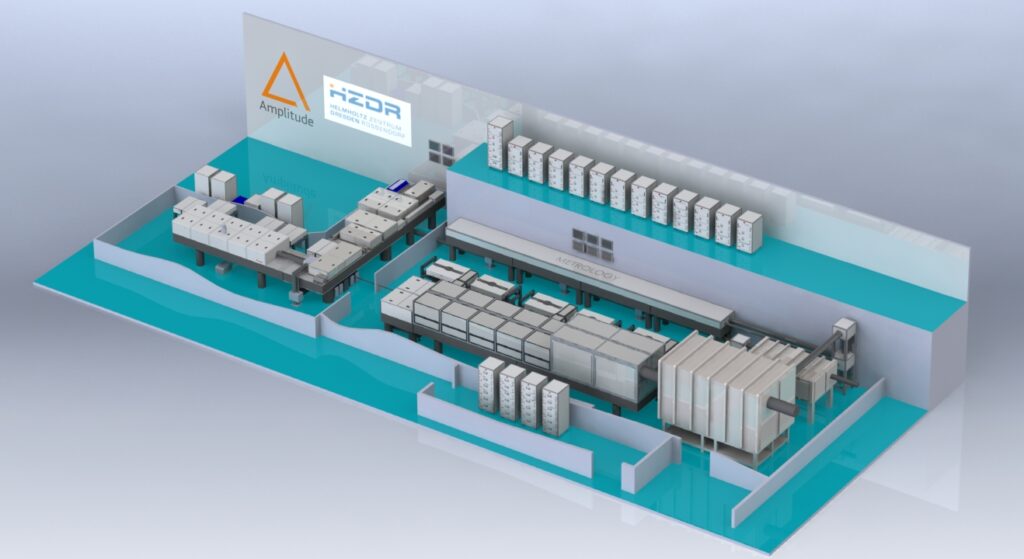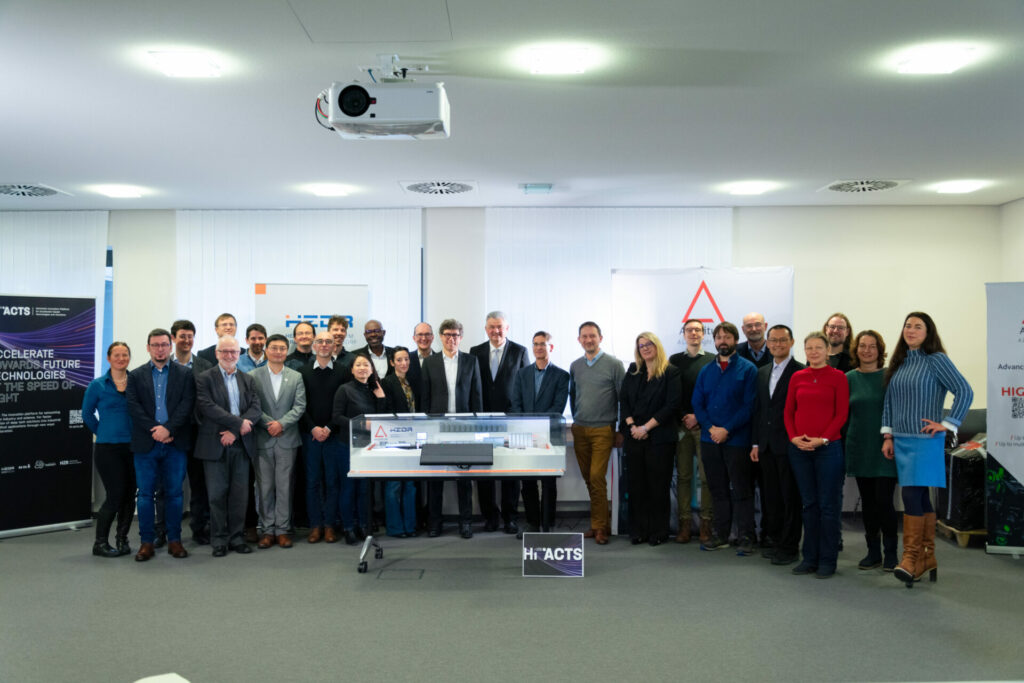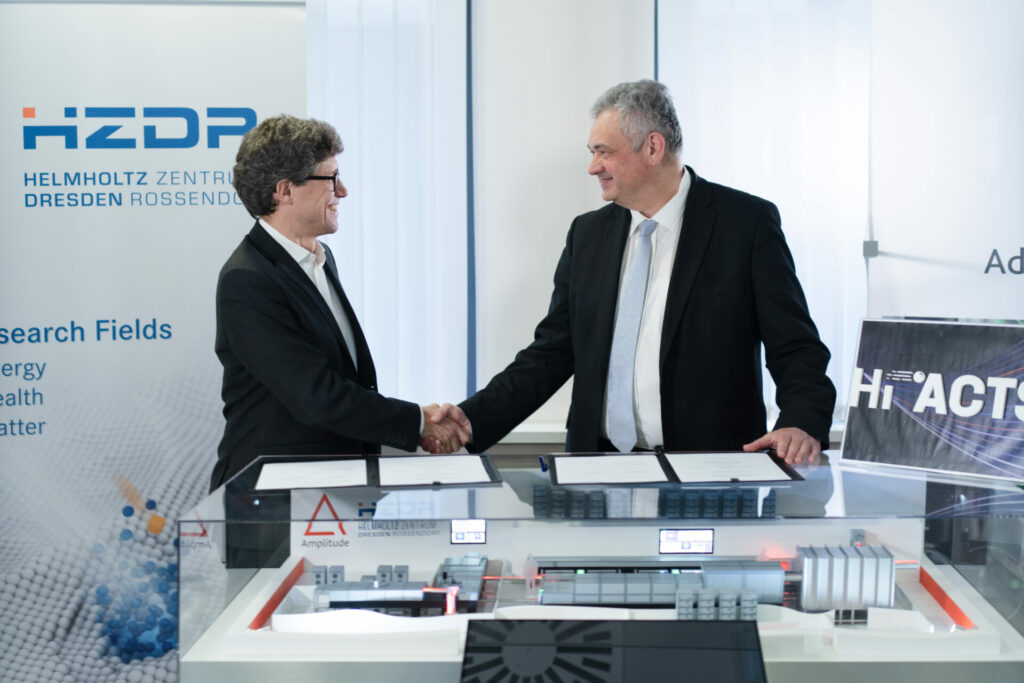Next-Generation Lasers for Pioneering Research
Amplitude and HZDR strengthen collaboration with new research lab
Amplitude Laser Group and Helmholtz-Zentrum Dresden-Rossendorf (HZDR) are deepening their 18-year collaboration by launching a joint research laboratory in Dresden. Building on joint work with the high-power laser DRACO, the strategic partnership aims to advance laser diagnostics, components, and applications, with a focus on electron and proton acceleration.
The titanium-sapphire laser system DRACO (Dresden laser acceleration source) at HZDR is one of the pioneering facilities driving relativistic laser plasma physics for novel particle accelerator concepts. Installed in 2007 by Amplitude, the system has since evolved through a close partnership between Amplitude and HZDR to become one of the world-leading two-beam facilities that it is today.

Driving Innovation with the Joint Laboratory
The new joint laboratory will spearhead advancements in next-generation titanium-sapphire laser technologies around the DRACO laser, targeting high-energy and high-repetition rate systems with improved stability, temporal contrast, and performance. It will also support the development of secondary radiation sources and enable technologies that surpass current standards, including high-dose rate radiobiology in the context of cancer research and inertial fusion energy applications.
To strengthen this successful collaboration, Amplitude will dedicate Research and Development resources from its Lisses facility in France to Dresden. The laboratory’s work will focus on creating innovative solutions for laser technology, secondary sources, and laser metrology. Further bolstering these efforts, Amplitude will fund PhD positions at HZDR and establish a local team in Dresden, ensuring a strong and sustainable presence in the region.
Damien Buet, CEO of Amplitude Laser Group, states: “Our long-term collaboration with HZDR has laid the foundation for this exciting new chapter. The joint lab will drive innovation, pushing high-power laser technology to new heights and shaping a brighter future.”
Prof. Sebastian M. Schmidt, Scientific Director at HZDR, continues: “Thanks to Hi-Acts, our Helmholtz Innovation Platform for Accelerator-based Technologies & Solutions, we are able to build strong collaborations with industry leaders like Amplitude Laser Group. Our new joint lab will give us many opportunities to transfer research directly into applications.”
The joint laboratory will follow a clear governance structure to ensure effective collaboration. The Steering Board, led by Prof. Ulrich Schramm, Director at HZDR’s Institute of Radiation Physics, and Dr. Pierre-Mary Paul, Vice President Advanced Laser Solutions at Amplitude, will guide strategic direction. Day-to-day operations will be managed by Project Management leads Stefan Bock (HZDR) and Émilien Gontier (Amplitude).
Prof. Dr. Ulrich Schramm highlights: “Recent breakthroughs in laser plasma accelerator research, like record-breaking proton energies or the demonstration of free-electron-lasing, originated from improved control over laser parameters on target. Advanced metrology and corresponding feedback to the laser chain will thus be essential to further progress.”
Dr. Pierre-Mary Paul concludes: “Advancing next-generation laser technologies allows us to push the boundaries of scientific research, enable groundbreaking applications using laser-based secondary sources, and lay the groundwork for scalable industrial solutions.”


About Hi-Acts:
The Hi-Acts innovation platform makes accelerator-based technologies more accessible for industry and medicine. Combining their expertise, the five Helmholtz centers Deutsches Elektronen-Synchrotron DESY, Helmholtz-Zentrum Dresden-Rossendorf, GSI Helmholtzzentrum für Schwerionenforschung, Helmholtz-Zentrum Hereon, and Helmholtz-Zentrum Berlin offer access to their numerous accelerator facilities and research groups. With the strategic partnership between Amplitude and HZDR, the Hi-Acts platform broadens its network in Europe and strengthens Franco-German relations. It also opens up access to funding programs within the network to enhance pioneering deep-tech solutions.
About HZDR:
The Helmholtz-Zentrum Dresden-Rossendorf (HZDR) performs – as an independent German research center – research in the fields of energy, health, and matter. We focus on answering the following questions:
- How can energy and resources be utilized in an efficient, safe, and sustainable way?
- How can malignant tumors be more precisely visualized, characterized, and more effectively treated?
- How do matter and materials behave under the influence of strong fields and in smallest dimensions?
To help answer these research questions, HZDR operates large-scale facilities, which are also used by visiting researchers: the Ion Beam Center, the Dresden High Magnetic Field Laboratory, and the ELBE Center for High-Power Radiation Sources. HZDR is a member of the Helmholtz Association and has six sites (Dresden, Freiberg, Görlitz, Grenoble, Leipzig, Schenefeld near Hamburg) with almost 1,500 members of staff, of whom about 680 are scientists, including 200 Ph.D. candidates.